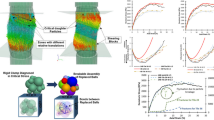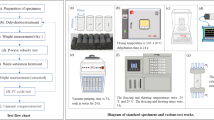Abstract
Advances in materials science have shown that material behavior varies according to the rate of load application (strain-rate sensitivity). With regards to compressive strength, materials have been observed to exhibit a strengthening, weakening, or negligible response to increasing strain-rates (Zhang and Zhao in Rock Mech Rock Eng 47(4):1411–1478, 2014). Practical experimentation to ascertain these responses has been carried out for over a century, based on the fundamental equipment design pioneered by John Hopkinson in 1872 and modified by Kolsky in 1949. A contemporary Split-Hopkinson Pressure Bar (SHPB) has been constructed at the University of Kentucky (UKY) to research the dynamic properties of various geologic materials for mining and civil engineering applications. Geologic samples are of an inconsistent nature due to inherent discontinuities and large grain size. To ensure test specimens are of adequate size to reflect this inconsistent nature, the SHPB at the UKY has been constructed with component bars of 2 in. (5.08 cm) diameter. Prior publications have discussed various considerations associated with the testing procedure and data processing of this SHPB (dispersion correction, pulse shaping, etc.) (Silva and Lamont 2017). This publication presents the results of materials testing with this SHPB. Three materials were selected: Bedford (Indiana) Limestone, Berea (Ohio) Sandstone, and Aluminum 6061-T6. Two of these are common aggregates found in the mining and construction industries, while the third is an aluminum variant often encountered in industrial applications. Dynamic compression testing of these materials at various strain rates was carried out, and the results are included. Static test results have been included for comparison, and the testing and data analysis procedure are discussed in detail.





















Similar content being viewed by others
References
ASM International (1990) Metals handbook, volume 2: properties and selection: nonferrous alloys and special-purpose materials, 10 edn. ASM International
Broch E (1983) Estimation of strength anisotropy using the point-load test. Int J Rock Mech Min Sci Geomech Abstr 20(4):181–187
Chen W, Zhang B, Forrestal MJ (1999) A split Hopkinson bar technique for low-impedance materials. Exp Mech 39(2):81–85
Churcher PL, French PR, Shaw JC, Schramm LL (1991) Rock properties of Berea sandstone, Baker dolomite, and Indiana limestone. Soc Pet Eng. https://doi.org/10.2118/21044-ms
Davies EDH, Hunter SC (1963) The dynamic compression testing of solids by the method of the split Hopkinson pressure bar. J Mech Phys Solids 11(3):155–179
Forster IR (1983) The influence of core sample geometry on the axial point-load test. Int J Rock Mech Min Sci Geomech Abstr 20(6):291–295
Frew DJ, Forrestal MJ, Chen W (2001) A split Hopkinson pressure bar technique to determine compressive stress–strain data for rock materials. Exp Mech 41(1):40–46
Frew DJ, Forrestal MJ, Chen W (2002) Pulse shaping techniques for testing brittle materials with a split Hopkinson pressure bar. Exp Mech 42(1):93–106
Gama BA, Lopatnikov SL, Gillespie JW Jr (2004) Hopkinson bar experimental technique: a critical review. Appl Mech Rev 57(4):223–250
Gong JC, Malvern LE, Jenkins DA (1990) Dispersion investigation in the split Hopkinson pressure bar. J Eng Mater Technol 112(3):309–314
Gray GT III (2000) Classic split Hopkinson pressure bar testing. ASM Handb Mech Test Eval 8:462–476
Hill JR (2017) Indiana geological and water survey, “Indiana limestone”. https://igs.indiana.edu/MineralResources/limestone.cfm. Accessed 11 Mar 2018
Holt JM (1996) Structural alloys handbook, Technical Ed; Ho CY (ed) CINDAS/Purdue University, West Lafayette, IN
Kaiser MA (1998) Advancements in the split Hopkinson bar test. Diss. Virginia Tech
Liu S et al (2011) SHPB experimental study of sericite-quartz schist and sandstone. Chin J Rock Mech Eng 30(9):1864–1871
Lu YB, Li QM (2010) Appraisal of pulse-shaping technique in split Hopkinson pressure bar tests for brittle materials. Int J Prot Struct 1(3):363–390
Manes A et al (2011) Analysis of strain rate behavior of an Al 6061 T6 alloy. Proc Eng 10:3477–3482
Petrov Y, Selyutina N (2015) Scale and size effects in dynamic fracture of concretes and rocks. In: EPJ web of conferences, vol 94. EDP Sciences
Ravichandran G, Subhash G (1994) Critical appraisal of limiting strain rates for compression testing of ceramics in a split Hopkinson pressure bar. J Am Ceram Soc 77(1):263–267
Shankland TJ, Johnson PA, Hopson TM (1993) Elastic wave attenuation and velocity of Berea sandstone measured in the frequency domain. Geophys Res Lett 20(5):391–394
Silva J, Lamont R (2017) Dispersion signal analysis in a Split-Hopkinson pressure bar at the University of Kentucky. Fragblast Int J Blast Fragm 11(1):7–22
Subhash G, Ravichandran G (2000) Split-Hopkinson pressure bar testing of ceramics. ASM International, Materials Park, OH, pp 497–504
Wu XJ, Gorham DA (1997) Stress equilibrium in the split Hopkinson pressure bar test. J Phys IV 7(C3):C3–91
Zhang QB, Zhao J (2014) A review of dynamic experimental techniques and mechanical behaviour of rock materials. Rock Mech Rock Eng 47(4):1411–1478
Acknowledgements
This research was internally funded by the University of Kentucky’s Explosives Research Team.
Author information
Authors and Affiliations
Corresponding author
Rights and permissions
About this article
Cite this article
Lamont, R., Silva, J. Dynamic Properties of Geologic Specimens Subjected to Split-Hopkinson Pressure Bar Compression Testing at the University of Kentucky. Geotech Geol Eng 37, 897–913 (2019). https://doi.org/10.1007/s10706-018-0659-8
Received:
Accepted:
Published:
Issue Date:
DOI: https://doi.org/10.1007/s10706-018-0659-8




